Source: Tiger Sniffing APP
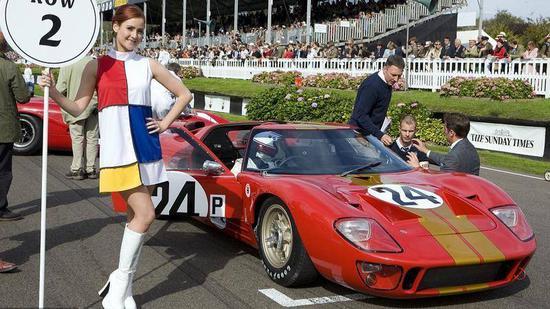
Original title: If you don’t sell yourself, I will hammer you.
Author: Sun Mingyuan
On May 21st, 1963, Don Fryer, Vice President of Ford, and many senior executives arrived in Maranello. In a small conference room, there were all Ford and a team of professional lawyers at one end, and Enzo Ferrari and several local lawyers at the other end. At first, it seemed to go smoothly, but suddenly Enzo put down his contract documents, took out his famous pen filled with purple ink from his suit and wrote on the left side of a paragraph: "No, I can’t accept this one!" "
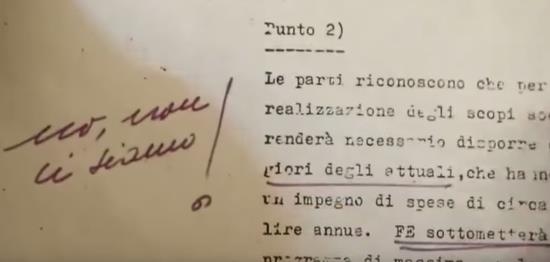
(Enzo wrote "No, that‘s not OK" with a purple ink pen on the left side of the contract, originally in Italian)
Then the two sides went through a long negotiation, and finally Enzo said faintly to the lawyer on the side, "Come on, let’s go to dinner." Then he got up and turned away with the lawyer, leaving Ford and his party and the lawyer team looking at each other.
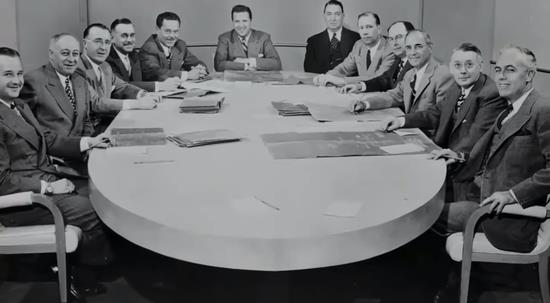
(Photo taken when Ford and his party signed a contract with Enzo Ferrari in 1963)
This means that Ford’s acquisition of Ferrari was a complete failure, and it also opened the curtain of the most touching "war" in the automobile industry in the last century.
prologue
In the 1960s, the hippie Beatles and the Rolling Stones were in full swing, and the Organization of Petroleum Exporting Countries (OPEC) was just established. At this time, the automobile industry is in the development period, especially in the United States. Low oil prices and convenient highways have made the American automobile industry enter a high-speed development stage. The main theme of the United States at that time was "Nothing is impossible", and all industries were trying to break records and create miracles.
After World War II, because Edsel Ford (son of Henry Ford) died young, and Henry Ford was old, and the company’s political struggle and other reasons, Ford was faced with great difficulties, and its sales plummeted. The company urgently needed a new leader.
So in 1943, Henry Ford II (the eldest son of edsel Ford), who was still serving in the Navy during World War II, was "recalled" to work in Ford and became the CEO of Ford Motor Company two years later. Through a series of management reforms and personnel changes, he successfully "saved" Ford, turned losses into profits in a few years, and listed Ford in 1956, which was comparable to GM and Chrysler at that time.
Although the sales volume was increasing, Ford was generally regarded as "a car company for the elderly" at that time. Even though Americans agreed that Ford was reliable and durable, it lacked exciting features and was not suitable for young people.
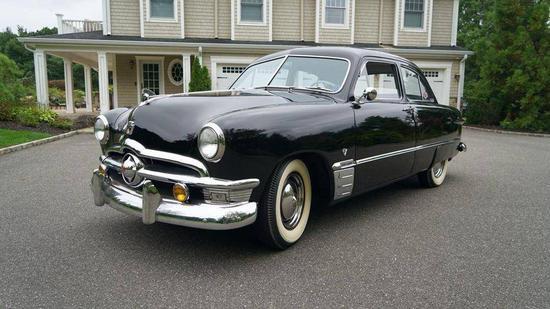
(Ford Tudor in 1950s)
Ford hoped to seize the youth market, and the best way at that time was to participate in international automobile competitions as an advertisement to change the "old" brand impression, so he founded the racing project "Total performance Program", which was in charge of Don Fryer, then vice president.
When Ford II searched all the lists, he found the Ferrari that was "on sale" at that time. At that time, Ferrari almost dominated the world racing competition, and the most influential one was the 24 Hours of Le Mans in France.
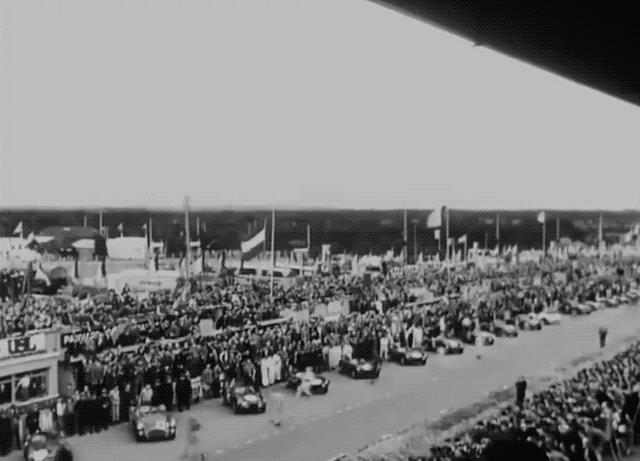
(Starting characteristics of 24-hour Mountain Endurance Race)
In 1929, Enzo Ferrari founded Scuderia Ferrari in Modena (translated as "Ferrari Stable", literally translated as Ferrari stable, that is, Ferrari team). It is not difficult to see from the name that Enzo has only focused on the field of racing since he founded Ferrari. At first, Ferrari existed as a racing division of Alfa Romeo. Later, in 1933, it replaced the original internal racing division and became the racing division of Alfa Romeo.
Later, the company dissolved the Ferrari team and made Enzo the captain of the newly established Alfa Corse team. So on September 6, 1939, Enzo decided to leave Alfa Romeo and set up his own company. However, due to the agreement signed when he left, he was not allowed to participate in any competition or car production under the name of Ferrari for four years. Enzo first founded a company in the former site of Ferrari team, engaged in the production of aircraft parts and related tools, and then produced the first Ferrari racing car-TiPO 815 (without Ferrari logo) based on Fiat platform in 1940.
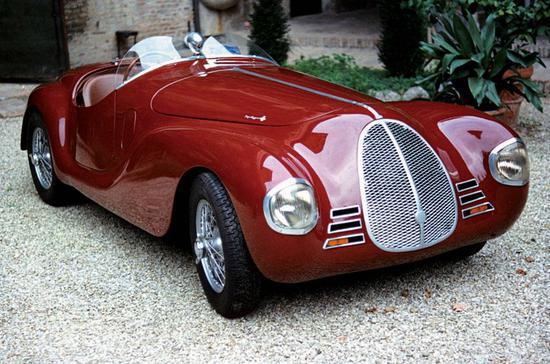
(Tipo 815)
In 1943, Enzo moved the factory to Maranello, and Ferrari has not changed its address since then. The car with Ferrari logo in the true sense is the 125 S produced in 1947, equipped with a 1.5-liter V12 engine, and Ferrari Motor Company officially "set sail".

(Ferrari 125S)
There is a joke called: "Ferrari without V12 engine is not called Ferrari at all."
The story behind this sentence is that Enzo never wanted to produce streetcars, nor did he want to compromise Ferrari’s proud V12 engine. But his son Dino didn’t think so. Dino had designed and developed Ferrari V6 engine and V8 engine, which was the source of V8 engine that Ferrari often used later. Although Enzo didn’t want to be disturbed by things outside the competition, the reality was cruel, and the funds needed to participate in the competition were amazing, so he had to compromise to produce streetcars to finance the team.
One is the American automobile empire, which is in urgent need of the injection of racing genes, and the other is the stubborn Italian racing fanatic, which is faced with huge funding problems. It seems to be a "hit it off" thing, but in fact Ferrari is "on sale" just because Enzo hopes to have capital inflow to ensure his racing career. So when Enzo saw that it was written in black and white "including the right to control and operate Ferrari cars", he turned down the $18 million acquisition contract without mercy.

(Enzo is dissatisfied with the content of the treaty, and the purple line is drawn.)
Ford II flew into a rage when the news of the failure of the negotiations returned to Detroit. Not only did Ford send Don Fryer, then vice president, to buy Ferrari, and spent nearly nine months in communication and negotiation, which cost more than $3 million in manpower and material resources, but finally only got a pile of "waste paper" on the table under Enzo’s back.
First battle Ferrari
The reason why Ford II was so angry was that his previous "efforts" went down the drain, and there was news that Enzo didn’t want to sell it to Ford at that time, just to show it to Fiat (Ferrari was acquired by Fiat in 1969), and Enzo once said to Ford II, "You are far less great than your grandfather Henry Ford."

(Henry Ford II)
In a rage, Ford II summoned all Ford’s right-hand men and gave a dead order: "Build me a car that can completely defeat Ferrari and conquer the French 24-hour Le Mans endurance race!"
At that time, Ford was not without racing experience, and Ford had achieved good results in American races such as Indy 500 and NASCAR. However, Le Mans Endurance Race is far away in Europe and France. The track is a daily road and only two lanes wide, with a lap of 8.3mile (about 13.357km), a total mileage of over 3,000 miles (4,828 km) and a top speed of up to 210 miles/h (338 km/h). It also faces various weather environments such as rain, fog and night during the 24-hour race. For Ford, this is tantamount to a novice challenge to Mount Everest.

(24-hour Le Mans Raceway)
So when Ford II said, "No matter how much it costs, I must win the XXX in Italy", many people thought this sentence was as unbelievable as President Kennedy’s "We are going to the moon".
In order to quickly adapt to European races, Ford found a small racing company in Britain-Lola Cars (a small company focusing on racing, located in Slough Industrial Park near London, the site is still there). They have European racing experience and existing mid-engine chassis, so they were hired to build chariots with Ford engineers.

However, time was too tight. In March 1964, it took only seven months, and the first prototype Ford GT equipped with a British chassis and a Ford engine came out. At that time, several drivers including Bruce Mclaren (founder of McLaren) did a lot of tests and improvements for GT, and initially solved many problems.

(Bruce Mclaren)
The extremely streamlined body is only 40 inches (1016mm) high, so it is named GT40. Equipped with the engine of Ford Indy 500, 4.2-liter V8, with about 350 horsepower, seems very promising.

(Ford GT40 Prototype)
However, in fact, due to the lack of experience in aerodynamic design at that time, the cooling air inlets designed at the front of the vehicle not only did not work, but also produced a lifting force, resulting in insufficient downforce of the vehicle. In April, 1964, Ford took the GT40 prototype to Le Mans Test Day. Although the speed was very fast, the whole vehicle had no stability and handling. Even on the straight track, it could lose its grip but slip and turn. This happened not just at the beginning, but at the speed of 170mile/h (about 273.6km/h).
The problem is not only in aerodynamics, but also in suspension. At that time, Ford didn’t understand why the vehicle was so unstable, because the GT40 crashed at the speed of 160mile/h(257.5km/h) that afternoon. Although Ford took two GT40s with him, the second one crashed the next day.
At this time, it was only two months before the 1964 Le Mans Endurance Race.
Despite the difficulties, Ford finally arrived at the Le Mans Endurance Race as scheduled with three GT40. On June 20, 1964, the race started as scheduled. Ford’s three GT40 took the lead in the second lap and even set an average speed record of 131mile/h/h (about 210.8km/h). However, in the end, all three cars failed to finish the race because of an accident or gearbox failure.
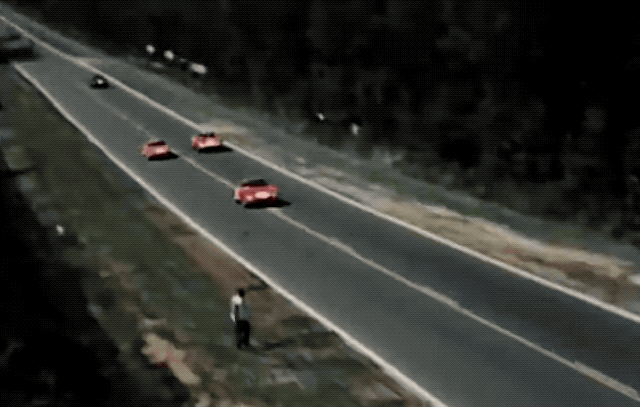
As a result, Ferrari won the championship for the fifth time in a row, beating Ford with the results of first, second and third place.
Fight Ferrari again
Ford II did not lose heart, but said, "We will come again next year and beat Ferrari!" "
After the first failure, Ford decided to let Carroll Shelby be the leader of GT40 project. Shelby is a famous American designer, racing driver and entrepreneur. He used to be a flight instructor and test pilot during World War II, and he worked as an oil worker and a chicken farm farmer after retiring. At first, as a racing amateur, he made amazing achievements in many races. In 1959, he won the 24-hour Le Mans Endurance Championship by driving aston martin DBR1.

(In 1956, Shelby took part in the Mount Washington Climbing Race in a Ferrari 375GP.)
Because Shelby suffered from heart valve leakage when he was 7 years old, he needed to take nitroglycerin for a long time to keep his heart normal. It is precisely because of this that Shelby was rejected by Ferrari as a driver. After 1959, Shelby stopped racing as a driver, but founded Shelby American Company in southern California, USA, whose business was to modify and produce racing cars. Because of the previous competition, he was very interested in a British company named AC Ace, and wanted to build a racing car with its chassis body and the developed V8 engine in the United States.
At that time, Corvette (owned by General Motors) rejected his request, but Ford extended an olive branch to him. Ford’s V8 engine at that time was not only able to generate powerful power in generate, but also very suitable for retrofitting and installing the chassis of existing AC Ace cars. In 1962, Shelby reached a cooperation with Ford and produced the first Cobra model in history-the famous AC Cobra 260.

(AC Cobra 260)
In fact, in 1964, when three Ford cars lost, Shelby American had a car (Shelby Daytona Cobra Coupe) with a 4.7L Ford engine and finished the race in the fourth place. In addition, in 1963 and 1964, AC Cobra with the same engine finished the race in the 7th and 18th places respectively.

So when Ford lost the first Le Mans race, Shelby came to mind first. In addition, Shelby’s engineering team has talented engineers (such as Phil Remington) who come to F1 and other competitions, including New Zealand, Japan, Australia, Italy, France, Germany and Britain. "A very cohesive team," Ford II commented.
“Carol was a Can-do, Let’s-get-it-done kind of guy and very much like my father, Carol had a very outgoing personality and I think that my father(Henry Ford II) personality and carol’s personality meshed reasonably well.” "Carol is a highly effective and very capable person, much like my father. His personality is very cheerful, which coincides with my father’s personality and gets along very well. "-Edsel Bryant Ford II (edsel Ford II, son of Henry Ford II)
Of course, I have to mention another legend here-Ken Miles, a British automobile engineer, racing driver and one of Shelby’s close friends. He served as a tank commander during World War II, and participated in car races and made racing cars after retiring. In 1953, he won 14 consecutive victories in SCCA League by driving his own car. Because of similar interests, Shelby invited Miles to join Shelby American and become the chief test driver. Together, they built the famous AC Corbra and Shelby GT350.

(left Bruce Mclaren, right Ken Miles)
When Shelby received the heavy responsibility, he first asked Miles to test the GT40 in Riverside International Raceway in Southern California. As a result, several drivers said the same sentence after the test: "It’s bloody awesome, I hate it.."
The extreme instability of the vehicle and many problems have made the team sweat.
Next, the whole team began to work day and night, and even ate amphetamine as jelly beans. Starting with aerodynamics, the problem of body modeling is solved first; Then the original Ford 4.2-liter V8 engine was replaced by Ford 4.7-liter V8 engine, which improved the power a lot. Then the gearbox was replaced by a 5-speed gearbox made by ZF in Germany, and the reliability was improved. In addition, the cooling system, suspension, wheel hub, tires and other parts are modified and optimized. The new model GT40 Mk1 Daytona is almost the same as the original GT40 Mk1 (after the new model is released, the first generation of models participating in Le Mans will be called MK1 to distinguish different GT40, and then the code will be added later). You can even think that Shelby and Miles have applied many experiences from Shelby Daytona Cobra Coupe to GT40.

(1965 GT40 Mk1 Daytona)
The transformed GT40 Mk1 Daytona is indeed much better than before, and even won the 2000km endurance race in Daytona Continental, defeating Ferrari P2 driven by John Surtees (legendary driver, the only one who has won two and four world championships so far, and the oldest surviving F1 world champion). And won the second and third place in the next 12 hours of Sebring endurance race. However, due to problems such as gearbox, some races that GT40 Mk1 Daytona participated in later ended in failure.

(In 1965, three Ferrari cars crossed the line at the same time in the 24-hour Le Mans endurance race)
In 1965, the French 24 Hours Le Mans Endurance Race was held again. This time, six Ford GT40 (different versions) participated, but none of them was able to finish the race. Ferrari once again "humiliated" Ford’s ambition and won five consecutive championships.
Three wars Ferrari
So far, Ford has invested millions of dollars in the GT40 project, but none of the cars have completed the Le Mans race. Ford II is faced with a dilemma, either to give up the "war" with Ferrari and stop investing, or to continue to increase investment and "crash" Ferrari.
The answer given by Ford II was to send a card with a name to everyone involved in the project, and a sentence was written under the name: "You‘d better win! (In the interview, Shelby recalled "Ford wins Le Mans in 1966")
When Ford II handed the cards to the team members one by one, Shelby and several engineers asked, "What about the financial budget restrictions?"
Ford only replied: "You are only responsible for winning, and don’t worry about anything else!"
In order to continue to improve GT40, Myers and his team have invested thousands of hours in testing and research. The new GT40 Mk2 has further increased the engine displacement, from 4.7-liter V8 to 7.0-liter V8 (the engine used by Ford for NASCAR). Because of the engine with such a huge volume and power, the chassis structure has been strengthened, the suspension system has been upgraded, the cooling system has been optimized, and the braking system has been improved … The new GT40 Mk2 will no longer be extremely unstable, even at the speed of 210mile/h (about 338km/h), it is still rock-solid.

(GT40 Mk2, the one that Ken Miles drove in 1966 still exists in the world, worth more than 15 million pounds).
What is even more exaggerated is that Shelby, Myers and Ford team jointly developed a set of computer simulation equipment, which can simulate the whole gearbox working condition of Le Mans race. The reason why the gearbox has always been a "drag" before is that on the one hand, the engine power and torque have risen sharply on the existing power system, and the gearbox has not had enough time to verify its reliability; On the other hand, at that time, the Le Mans race had to shift gears nearly 9000 times, and it was easy to go wrong after 24 hours of continuous high-intensity use on the Le Mans track, which tortured the car. (For example, in 1965, several P2 models sent by Ferrari failed to complete the race because of the gearbox).

Although this set of gearbox simulation equipment later became the standard equipment in the development of F1 racing cars, it was almost witchcraft at that time. Through computer signal transmission, every gear shift in the whole Le Mans race is actually simulated, and the gearbox is also connected to the engine to simulate the real racing situation.

The date of the duel between David and Gliath is approaching.
The Italians didn’t stand still at this time. In order to cope with Ford’s menacing challenge, Ferrari took out the P3 model that had just been produced. The streamlined body is even more exaggerated than GT40, and the height of 37.4inch (about 95 cm) is even lower than GT40. At that time, the top speed of GT40 was a little more than 210mile/h/h (about 338km/h), while the top speed of P3 was only 190mile/h/h (about 305.8km/h). However, Enzo was willing to sacrifice some top speed for lightness and flexibility, so that P3 control would be better without accidents in the narrow track, and it would be possible to refuel in P room less times.

(Ferrari P3, now worth more than 20 million pounds)
On June 18th, 1966, Ford brought the Armada-8 GT40, 20 tons of spare parts, and a team of top racers (Kim Myers, Bruce McLaren, etc.).
Ford II was invited as the opening guest of that year’s Le Mans Endurance Race. With the flag waving in his hand, the race officially started. At first, Ford relied on strong speed to gain the lead, but when the time came, Ferrari regained the first and second positions with more flexible maneuverability and fuel economy.
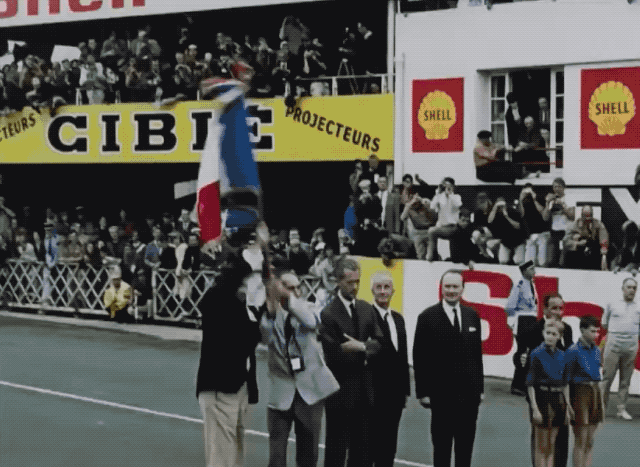
(Ford II waves the flag and the game begins)
On the contrary, Ford was asked to strictly implement the strategy of "drive carefully, don’t be reckless" because of the painful memory of "bow and snake shadow" However, one person in the team ignored this instruction, and Kim Myers decided to give it a shot, constantly setting a shocking lap record and regaining the leading position from Ferrari.
The next morning, when the morning sun shone on Le Mans, France, three P3 cars brought by Ferrari either broke down on the side of the road due to mechanical failure or had a serious accident and had to retire.

On the afternoon of June 19th, three GT40MK2s passed the finish line side by side with the cheers of the audience and all Ford people, and won the first, second and third place, and won the 24 Hours of Le Mans in France in 1966, which shattered Ferrari’s dream of winning six consecutive championships.
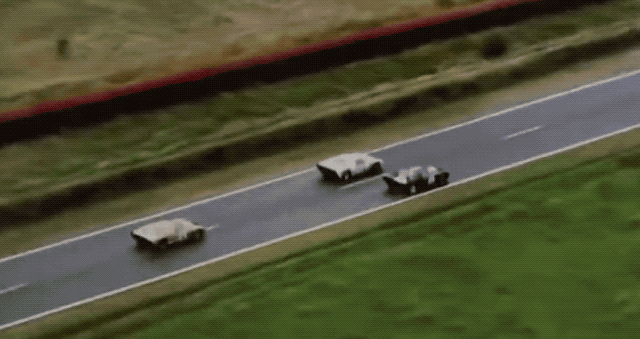
(In 1966, three GT40 cars crossed the line at the same time)
This is a great victory that goes down in history, and it is also the most unforgettable moment in the history of automobiles, and it is also the starting point for Ford’s glory.
“It was one terrific time, one that could never repeat again.” ——Carroll Shelby
postscript
Ford, who was on a roll, successively won the following three French 24-hour Le Mans Endurance Championship, but it is a pity that Kim Myers, who helped Ford win all these dazzling achievements, failed to witness the subsequent glory.

(GT40 J-Car)
After Mk2′ s total victory, Ford did not stop, but continued to improve its aerodynamics and chassis. Two months after the race, when the test car GT40 J-car was tested at Riverside International Raceway in Southern California, Myers died in an accident, and his son witnessed it by the track.

(Ken Miles)
What is even more regrettable is that in the Le Mans race in 1966, because the victory was already locked, Ford hoped that the three cars could cross the line together and let the reporter take this unforgettable scene, so Myers slowed down and waited for the other two cars to catch up before crossing the line together. However, although Miles’ car passed the finish line first, the organizer suddenly put forward an unknown rule. Because Bruce McLaren’s parking space was a distance behind Miles’ car, according to the total length, McLaren won the first place. As a result, Miles missed out on the "Grand Slam" of the three most influential events (Le Mans, Sebring and Daytona) in 1966.
After the death of Miles, the project was suspended for two months. After that, Ford introduced a brand-new model GT40 Mk4, which has a brand-new body, suspension and brakes compared with Mk2, and a new model with big tires and brakes. In Le Mans linear track, it can be 50mile/h/h faster than Mk2 (about 80.5km/h), and it also uses a 7.0-liter V8 engine equipped with Mk2. (6200 rpm in 1st gear can accelerate to 144.8km/h)

(GT40 Mk4)
In 1967, when many people thought that Ford only won the race by "luck" last year, Dan Gurney drove the GT40 Mk4 to cross the finish line again in the first place.
On the podium, Gurney had a whim, throwing a long-shaken bottle of champagne at the crowd and reporters, becoming the first person in the history of racing to make this celebration, and this habit has been "used" to this day.

(Gurney sprayed champagne on the crowd at the award ceremony in 1967)
After that, Ford decided to withdraw from Le Mans. On the one hand, Ford has proved its strength and achieved the expected goal. On the other hand, FIA announced a new rule in 1967, "The engine displacement of participating vehicles should not exceed 5 liters". Gurney once joked in an interview: "Europeans know that if they don’t change the rules, they can’t take the championship from the Americans."
However, in the 1968 and 1969 French 24 Hours Le Mans Endurance Race, John Wyer (team manager when Shelby won the Le Mans championship in Aston Martin in 1959, left Aston Martin in 1963, joined Ford in 1964 and participated in the research and development process of GT40) changed the model with Ford GT40 Mk1 (4.9-liter V8 engine) in the name of his own company (JW Automotive Engineering).
When the rules were changed again in 1969, GT40 completely withdrew from the 24-hour Le Mans race in France.
Nowadays, it is difficult to calculate how much Henry Ford II invested in this battle. Some experts speculate that according to today’s monetary value, Ford spent about 360 million pounds to teach Ferrari a lesson.
If there were no political reasons for Ferrari’s team management, which led to the replacement of Ferrari’s legendary driver John Sutis before the race in 1966, it might be hard to say whether it would be won or lost that year. If Kim Myers hadn’t died young two months after that victory, perhaps Ford would have won more glory in the racing world. If …
In fact, there are countless ifs, but we just need to remember that carote Shelby and Kim Myers have made indelible contributions in this great "battle", and there are still many people’s contributions in the GT40 project. Ford II is definitely a great figure in the history of automobiles …
“I want my legacy to be I want to make sure those people are recognized, they were pioneers.”——Carroll Shelby
More than 50 years have passed, and that embarrassing legend has left us not only a legendary GT40, but also a splendid automobile culture.
References:
Grand Tour Season 1 Episode 6.Ford VS Ferrari, which will be released in North America on November 15th, has not yet been set in China.Behind the Headlights documentary.The Carroll Shelby Story, the autobiography of Shelby.Interviews with Legendary Designers & Engineers, interview with Shelby on October 12, 1997.Racing in the blood: the story of the Ford GT40, website of Motoring Research.
Reporting/feedback